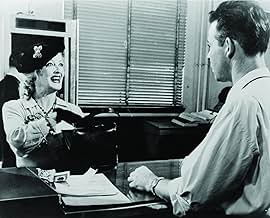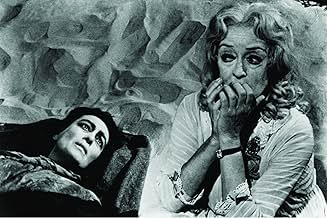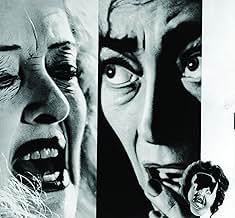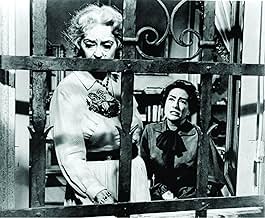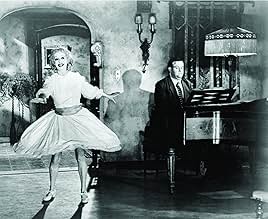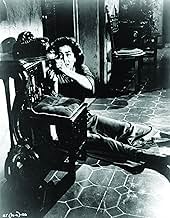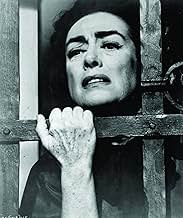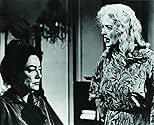एक पूर्व बाल कलाकार हॉलीवुड की हवेली में अपनी परोपकारी बहन को सताता है।एक पूर्व बाल कलाकार हॉलीवुड की हवेली में अपनी परोपकारी बहन को सताता है।एक पूर्व बाल कलाकार हॉलीवुड की हवेली में अपनी परोपकारी बहन को सताता है।
- 1 ऑस्कर जीते
- 5 जीत और कुल 11 नामांकन
Anne Barton
- Cora Hudson
- (as Ann Barton)
Barbara Merrill
- Liza Bates
- (as B.D. Merrill)
फ़ीचर्ड समीक्षाएं
I've always being a fan of What Ever Happened To Baby Jane. I saw it for the first time as a teenager and Bette and Joan became my obsession. I tried to see everything they had done and did I? All About Eve, The Little Foxes, Now Voyager as well as Mildred Pierce, Humoresque. I warmed up quicker to Bette. Her horrible women were priceless and she was fearless. Joan Crawford kept me at a distance, I think the cosmetics got in the way. But now, watching Baby Jane in 2017 - thanks to the amazing Ryan Murphy series "Feud" - I saw a very different Crawford and her performance has grown in scope and depth. I know I shall see this film again. Fascinating to realize there is still so much to discover.
Whatever Happened to Baby Jane? might seem dated, but it is still an extremely riveting watch. I literally could not look away, as soon as the movie started, I couldn't stop until it had finished. Not a lot of movies can do that to me. The acting is extremely good, Bette Davis and Joan Crawford are just so good as the main focus of the movie. The chilling score is suits the movie and the camera-work reminds me a lot of Hitchcock.
The story focuses on two sisters, Blanche Hudson (Joan Crawford) who was crippled in an accident awhile ago and "Baby" Jane Hudson (Bette Davis). Jane used to be a big child star, she even had a doll brand after her. Now, though, she is no longer recognised while her sister has recently become very famous. They live in an old mansion, with Blanche confined to her room upstairs while Jane gets madder and more cruel by the day.
Bette Davis gives the star performance here, some may call it over-acting but it is far from. She really makes Jane as mad, cruel and sad as possible. Joan Crawford is equally good in a very different role. She is much more timid then Jane and quite scared. The supporting cast are all good as well, especially Victor Buono as Victor Flagg, an odd pianist that befriends Jane. The black and white really are used to full effect, they make the mansion look extra creepy. Robert Aldrich's direction is fine.
To today's modern audience, this may seem boring as it does not have any action. Most of the movie is dialogue, but I do urge those who haven't seen it to do so, as it is a truly excellent movie.
A solid 5/5!
The story focuses on two sisters, Blanche Hudson (Joan Crawford) who was crippled in an accident awhile ago and "Baby" Jane Hudson (Bette Davis). Jane used to be a big child star, she even had a doll brand after her. Now, though, she is no longer recognised while her sister has recently become very famous. They live in an old mansion, with Blanche confined to her room upstairs while Jane gets madder and more cruel by the day.
Bette Davis gives the star performance here, some may call it over-acting but it is far from. She really makes Jane as mad, cruel and sad as possible. Joan Crawford is equally good in a very different role. She is much more timid then Jane and quite scared. The supporting cast are all good as well, especially Victor Buono as Victor Flagg, an odd pianist that befriends Jane. The black and white really are used to full effect, they make the mansion look extra creepy. Robert Aldrich's direction is fine.
To today's modern audience, this may seem boring as it does not have any action. Most of the movie is dialogue, but I do urge those who haven't seen it to do so, as it is a truly excellent movie.
A solid 5/5!
"What Ever Happened to Baby Jane?" is a most unusual and impressive thriller. Director Robert Aldrich achieves a fantastic sordid and dark atmosphere at the Huadson sisters mansion -where most of the action takes place- with an unusual black and white shooting for the early 60's. An interesting story, a well delivered screenplay and an accurate musical score also rise the film high.
But the main credit of the picture is casting together to real big names in Hollywood's history, not at their peak then but always reliable and attractive to see. Bette Davis (Jane) takes the most interesting character as the former child star that couldn't make it as an adult in show business so she has gone insane and keeps behaving as the spoiled child he was. She looks grotesque and ridiculous in her child outfits, hairdo and heavy make up. Davis is outstanding in her role and looks really mean when she tortures both mentally and physically her sister Blanche, delicate and reasonable. Joan Crawford plays Blanche and very well too, a former big star whose career ended after a strange car accident that put her on a wheel chair for life.
In the end things are not completely as they seem but the final twist is not what makes this film an extremely good one; it's the strange relationship between the sisters, that requires of that final twist to understand Blanche's tolerant conduct towards her sister.
The movie is perhaps a little too long and it would probably have been even better with a 10 minutes cut. But no doubt this is a top product in its genre and a great movie indeed.
But the main credit of the picture is casting together to real big names in Hollywood's history, not at their peak then but always reliable and attractive to see. Bette Davis (Jane) takes the most interesting character as the former child star that couldn't make it as an adult in show business so she has gone insane and keeps behaving as the spoiled child he was. She looks grotesque and ridiculous in her child outfits, hairdo and heavy make up. Davis is outstanding in her role and looks really mean when she tortures both mentally and physically her sister Blanche, delicate and reasonable. Joan Crawford plays Blanche and very well too, a former big star whose career ended after a strange car accident that put her on a wheel chair for life.
In the end things are not completely as they seem but the final twist is not what makes this film an extremely good one; it's the strange relationship between the sisters, that requires of that final twist to understand Blanche's tolerant conduct towards her sister.
The movie is perhaps a little too long and it would probably have been even better with a 10 minutes cut. But no doubt this is a top product in its genre and a great movie indeed.
Interesting, to see comments dismissing WEHTBJ? as a "gay" film, or "cult" film, etc.
As a writer/producer who lived and worked in Hollywood for 30 years, I submit that those comments represent a "denial syndrome" of people who are ignorant of the facts of Hollywood.
What is so "horrifying" about WEHTBJ? is that the film is an utterly realistic psychodrama about two specific sisters of that era.
It's easy to say that Bette Davis' performance/makeup was "over the top," except that they weren't. In fact, I thought her look was taken from a sad "street person" in Hollywood who, in her seventies, walked up and down Hollywood Boulevard in a pink ball-gown and dead blonde wig and thick makeup, speaking into a transistor radio she held to her ear -- in the 60s, long before cell phones -- "talking" to the FBI about people chasing her.
Perhaps those who've spent their lives elsewhere, other than in Hollywood, feel that the characters in WEHTBJ? are "over the top." But they're not.
That's what makes them so heartbreaking. And the incredibly brave performances by Joan Crawford, Bette Davis, Victor Bono and the rest -- not to mention the script and Robert Aldrich's direction -- make this simply the most definitive "Hollywood" psycho-thriller since "Sunset Boulevard."
There's "A Star Is Born," in any of its incarnations. Which is also "true" in its (their) way.
And there is "Sunset Boulevard" and "Baby Jane," which are even more true, and more brilliantly made.
These are not "horror films." They are riveting psychological studies, cast with astonishing actors, and magnificently directed and photographed.
They are the equivalent of Hitchcock's "Psycho," IMHO, which was preceeded by "Sunset Boulevard" and followed by "Baby Jane."
Each different, each brilliant, each marked by some of the most indelible performances ever captured on film.
It's typical of adolescents to make a "joke" about things that make them uncomfortable.
But when experience and age acquaint one with people like Baby Jane and Norma Desmond and, yes, Norman Bates, what's the point of joking?
These three films will tell those characters' stories forever, and better than 99% of films ever made.
That's why they're classics.
As a writer/producer who lived and worked in Hollywood for 30 years, I submit that those comments represent a "denial syndrome" of people who are ignorant of the facts of Hollywood.
What is so "horrifying" about WEHTBJ? is that the film is an utterly realistic psychodrama about two specific sisters of that era.
It's easy to say that Bette Davis' performance/makeup was "over the top," except that they weren't. In fact, I thought her look was taken from a sad "street person" in Hollywood who, in her seventies, walked up and down Hollywood Boulevard in a pink ball-gown and dead blonde wig and thick makeup, speaking into a transistor radio she held to her ear -- in the 60s, long before cell phones -- "talking" to the FBI about people chasing her.
Perhaps those who've spent their lives elsewhere, other than in Hollywood, feel that the characters in WEHTBJ? are "over the top." But they're not.
That's what makes them so heartbreaking. And the incredibly brave performances by Joan Crawford, Bette Davis, Victor Bono and the rest -- not to mention the script and Robert Aldrich's direction -- make this simply the most definitive "Hollywood" psycho-thriller since "Sunset Boulevard."
There's "A Star Is Born," in any of its incarnations. Which is also "true" in its (their) way.
And there is "Sunset Boulevard" and "Baby Jane," which are even more true, and more brilliantly made.
These are not "horror films." They are riveting psychological studies, cast with astonishing actors, and magnificently directed and photographed.
They are the equivalent of Hitchcock's "Psycho," IMHO, which was preceeded by "Sunset Boulevard" and followed by "Baby Jane."
Each different, each brilliant, each marked by some of the most indelible performances ever captured on film.
It's typical of adolescents to make a "joke" about things that make them uncomfortable.
But when experience and age acquaint one with people like Baby Jane and Norma Desmond and, yes, Norman Bates, what's the point of joking?
These three films will tell those characters' stories forever, and better than 99% of films ever made.
That's why they're classics.
Two grand actresses, Bette and Joan, have their final screen showdown as--what else--retired show biz siblings. Bette's character achieves success early in vaudeville as Baby Jane Hudson, a child actress with a tendency for temper tantrums. As an adult Joan achieves tremendous success as film actress Blanche Hudson. Jane, however, is a horrendous actress, though Blanche makes sure that for every N pictures she makes, that Jane is featured in a film. If you look hard, you'll recognize the scenes from "Parachute Jumper" that the 30s studio execs are roasting in regards to Jane's performance.
A touch of Norma Desmond/Sunset Boulevard here--Bette as a delusional has-been who actually believes her career can be resurrected. Joan as the sister confined to a wheelchair as a result of a horrific car accident. In the drive-way. Supposedly run over by Baby Jane in the 1930s but never proven or prosecuted.
Fast forward to the 1960s, and Baby Jane takes it hard upon learning Blanche plans to sell their old stately mansion. She begins a systematic torture of Blanche that amounts to elder abuse in today's terms. Viewers who saw this film 60 years ago were frightened by the hair-raising dinner entrees given to Blanche: Her dead pet bird served up on a tray of tomatoes and the rat well-done. What doesn't hold up is Blanche's inability to bring attention to her imprisonment. For instance, her neighbor is outside below her window cutting flowers. Instead of screaming like a maniac for help, she writes a complicated note on a typewriter, balls it up, and throws it out the window. Of course, Baby Jane finds it. Duh. When the affected Victor Buono visits the house as a loony piano accompanist for Blanche, she could have screamed and yelled for help. She doesn't.
For all their competition, both Bette and Joan are good here and the ending is extremely ironic. Davis always claimed that Joan campaigned against her at Oscar time and that is why she didn't win. Davis certainly hadn't lost her willingness to look as unattractive as she needed to be in order to play the part. Overweight, dressed up like she is 10 not 55 with her hair in blonde curls and grotesque pancake makeup on, she is the ideal aged homicidal maniac of a Baby Jane doll. Joan's part requires much more subtlety to the point of not doing what she must to save herself. These two definitely make it a worthwhile watch.
A touch of Norma Desmond/Sunset Boulevard here--Bette as a delusional has-been who actually believes her career can be resurrected. Joan as the sister confined to a wheelchair as a result of a horrific car accident. In the drive-way. Supposedly run over by Baby Jane in the 1930s but never proven or prosecuted.
Fast forward to the 1960s, and Baby Jane takes it hard upon learning Blanche plans to sell their old stately mansion. She begins a systematic torture of Blanche that amounts to elder abuse in today's terms. Viewers who saw this film 60 years ago were frightened by the hair-raising dinner entrees given to Blanche: Her dead pet bird served up on a tray of tomatoes and the rat well-done. What doesn't hold up is Blanche's inability to bring attention to her imprisonment. For instance, her neighbor is outside below her window cutting flowers. Instead of screaming like a maniac for help, she writes a complicated note on a typewriter, balls it up, and throws it out the window. Of course, Baby Jane finds it. Duh. When the affected Victor Buono visits the house as a loony piano accompanist for Blanche, she could have screamed and yelled for help. She doesn't.
For all their competition, both Bette and Joan are good here and the ending is extremely ironic. Davis always claimed that Joan campaigned against her at Oscar time and that is why she didn't win. Davis certainly hadn't lost her willingness to look as unattractive as she needed to be in order to play the part. Overweight, dressed up like she is 10 not 55 with her hair in blonde curls and grotesque pancake makeup on, she is the ideal aged homicidal maniac of a Baby Jane doll. Joan's part requires much more subtlety to the point of not doing what she must to save herself. These two definitely make it a worthwhile watch.
क्या आपको पता है
- ट्रिवियाAccording to Bette Davis in her book "This N' That," the film was originally going to be shot in color. Davis opposed this, saying that it would just make a sad story look pretty.
- गूफ़In the 1935 time line (11 minutes into the film), Ben Golden (Bert Freed) and Marty McDonald (Wesley Addy) are walking past a row of buildings in the studio discussing Baby Jane's acting. There are window air conditioners in almost every upper floor window of the 2-story building behind them. But the first window air conditioner wasn't marketed until 1938, and it wasn't until 1947 that they were mass-produced.
- भाव
Blanche: Jane, do you remember when I first came back after the accident?
Jane: You promised you wouldn't ever talk about that again.
Blanche: I know I did. But I'm still in this chair. After all those years, I'm still in this chair. Doesn't that give you some kind of responsibility? Jane, I'm just trying to explain to you how things really are. You wouldn't be able to do these awful things to me if I weren't still in this chair.
Jane: But you *are*, Blanche! You *are* in that chair!
- इसके अलावा अन्य वर्जनThe original British release was cut in two places: in Reel Four, where Jane kicks Blanche only once instead of multiple times, and Reel Six, which eliminated some shots of Blanche tied up to the bed and writhing. Both cuts were mandated by the BBFC in order to receive an "X" certificate. Subsequent reissues restored the footage.
- कनेक्शनEdited into The Time That Remains (2012)
- साउंडट्रैकI've Written a Letter to Daddy
Music by Frank De Vol
Lyrics by Bob Merrill
Performed by Bette Davis
Also performed by Julie Allred (dubbed by Debbie Burton)
टॉप पसंद
रेटिंग देने के लिए साइन-इन करें और वैयक्तिकृत सुझावों के लिए वॉचलिस्ट करें
विवरण
- रिलीज़ की तारीख़
- कंट्री ऑफ़ ओरिजिन
- आधिकारिक साइट
- भाषा
- इस रूप में भी जाना जाता है
- बेबी जेन को कभी क्या हुआ?
- फ़िल्माने की जगहें
- उत्पादन कंपनी
- IMDbPro पर और कंपनी क्रेडिट देखें
बॉक्स ऑफ़िस
- बजट
- $9,80,000(अनुमानित)
- दुनिया भर में सकल
- $4,451
- चलने की अवधि2 घंटे 14 मिनट
- रंग
- पक्ष अनुपात
- 1.85 : 1
इस पेज में योगदान दें
किसी बदलाव का सुझाव दें या अनुपलब्ध कॉन्टेंट जोड़ें

टॉप गैप
By what name was What Ever Happened to Baby Jane? (1962) officially released in India in Hindi?
जवाब



